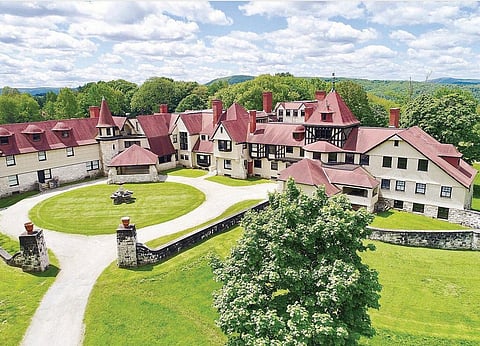Vanderbilt Mansion: A Gilded Age Gem with a Promising Future
Nestled in the picturesque Berkshires of Massachusetts, the Vanderbilt Mansion, formerly known as Elm Court, is a breathtaking relic of the Gilded Age, embodying the grandeur of a bygone era. Built in 1886 for Emily Vanderbilt, the granddaughter of Cornelius Vanderbilt, this architectural masterpiece has long captivated historians, preservationists, and admirers of luxury. Recently sold for $8 million to real estate investor and developer Linda Law, Elm Court is poised for a transformative restoration, with plans that may include a luxury resort featuring 112 guestrooms, a 15,000-square-foot spa, and a 60-seat restaurant.
A Mansion That Spans History—and Two Towns
Elm Court, designed by the acclaimed architectural firm Peabody & Stearns, boasts an impressive 55,000 square feet and 106 rooms, making it the largest shingled-style home in the United States. Its understated elegance, a hallmark of the New England architectural movement, contrasts with the ornate opulence of the Vanderbilt family's Biltmore House in North Carolina.
The estate's sheer size is matched by its unique geographical distinction: it spans the towns of Stockbridge and Lenox, Massachusetts. Renowned landscape architect Frederick Law Olmsted, celebrated for his work on New York’s Central Park, meticulously designed the estate's 40 acres of gardens, enhancing the mansion's timeless allure.
A National Historic Landmark with a Storied Past
Elm Court’s significance extends far beyond its architectural grandeur. It played a pivotal role in world history, hosting the Elm Court Talks in 1919, which ultimately contributed to the Treaty of Versailles and the creation of the League of Nations.
Over the decades, the mansion transitioned through various uses. After Emily Vanderbilt’s passing, her descendants converted the property into an inn during the 1940s. By the mid-20th century, it served as a venue for elegant dinners and events. However, Elm Court fell into dormancy for several decades, only to be revived in 1999 by Vanderbilt family descendants, who began an extensive renovation.
Preservation Meets Modern Luxury
Today, much of Elm Court’s original splendor has been lovingly preserved. The dining room’s intricately carved plaster ceiling, the herringbone-patterned wood floors, and the estate’s many fireplaces remain intact. Modern upgrades include a chef’s kitchen, complete with a large island and casual dining area, and a spacious mahogany butler’s pantry adorned with a charming window seat.
The estate encompasses more than just the main house. Additional buildings include a butler’s house, gardener’s cottage, and expansive greenhouses, one of which is large enough to cultivate fruit trees. A caretaker’s house, carriage house, stable, and two barns further add to the property’s grandeur.
Linda Law, the estate's new owner, has emphasized her commitment to preserving its historical integrity:
“Collectively, we have done a tremendous amount of research on the architecture and design of the Gilded Age and the history of the Vanderbilt family, and we feel a tremendous responsibility to pay homage to its legendary past. Equally as important, we will pay the utmost attention to the historical importance of Elm Court as its own entity, as well as its position and prominence in the Lenox and Stockbridge communities.”
Linda Law, Current Vanderbilt Mansion Owner
A Bright Future for a Gilded Age Icon
As Elm Court embarks on a new chapter, its potential transformation into a luxury resort signals an exciting future. Whether as a private retreat or an opulent destination for discerning travelers, this Vanderbilt mansion continues to captivate the imagination of all who encounter it.
Credit: toptenrealestatedeals.com
Inspired by what you read?
Get more stories like this—plus exclusive guides and resident recommendations—delivered to your inbox. Subscribe to our exclusive newsletter
Resident may include affiliate links or sponsored content in our features. These partnerships support our publication and allow us to continue sharing stories and recommendations with our readers.

